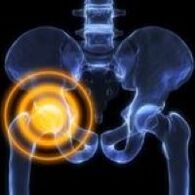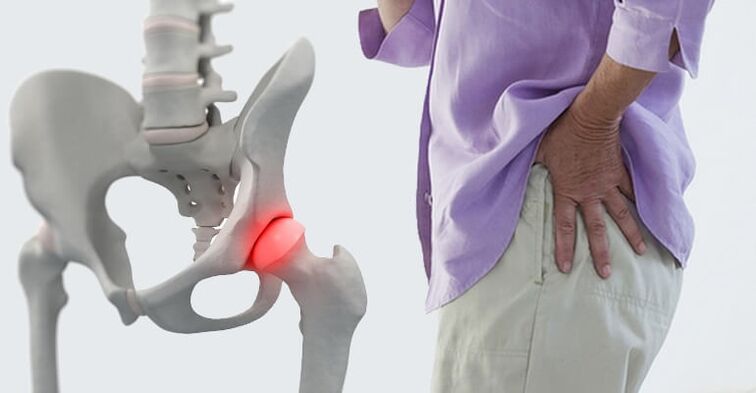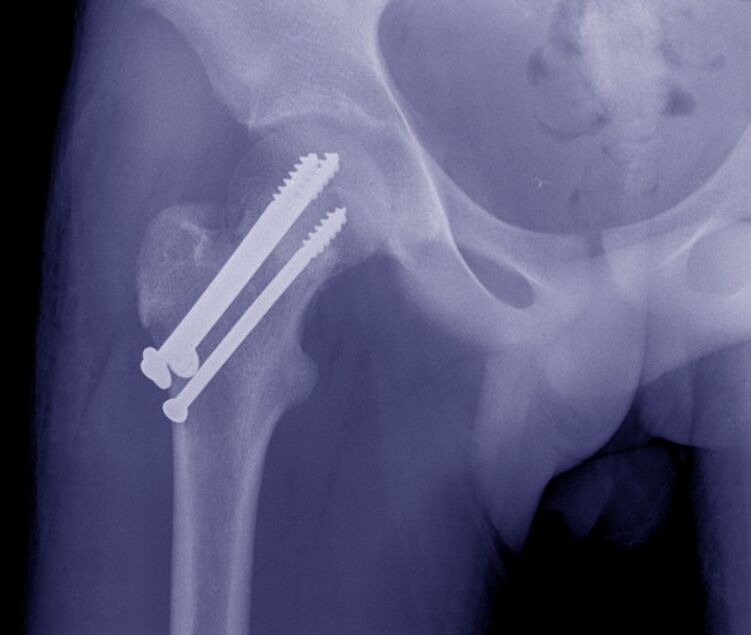Pain in the hip jointThey are specific unpleasant and difficult to bear sensations caused by pathology of the upper femur, acetabulum, nearby soft tissue structures. In terms of intensity, they range from weak to excruciating, in nature they can be dull, sharp, tight, sore, popping, piercing, etc. They often depend on the load, the time of day, and other factors. The causes of pain are determined by X-rays, CT scan, MRI, ultrasound, arthroscopy, and other studies. Pain relievers and limb rest are recommended until the diagnosis is made.
unpleasant and difficult to bear sensations caused by pathology of the upper femur, acetabulum, nearby soft tissue structures. In terms of intensity, they range from weak to excruciating, in nature they can be dull, sharp, tight, sore, popping, piercing, etc. They often depend on the load, the time of day, and other factors. The causes of pain are determined by X-rays, CT scan, MRI, ultrasound, arthroscopy, and other studies. Pain relievers and limb rest are recommended until the diagnosis is made.
Causes of pain in the hip joint.
Soft tissue injuries
The most common traumatic cause of pain is a contusion of the hip joint. It occurs when it falls on its side or a direct impact, manifests itself in a moderate sharp pain, which quickly becomes dull, gradually decreases and disappears within a few days, in severe cases - weeks. Support is preserved, movements are somewhat limited. Edema is detected locally, bruising is possible.
Injuries to the ligaments of the hip joint are rare, usually the result of traffic accidents and sports injuries, accompanied by severe pain, sometimes a cracking sensation (as from tearing of tissue). The pain subsides a bit, then often increases again due to edema. The swelling of the joint extends to the groin area, the thigh.
The degree of dysfunction in trauma to the ligamentous apparatus depends on the severity of the injury (stretching, tear, tear), ranging from mild limitation to inability to lean on the leg. Pain increases with deviation of the trunk, movements in the opposite direction to the damaged ligament.
Bone and joint injuries
Hip fractures generally occur in older people as a result of home or street trauma. A characteristic feature, especially in the presence of osteoporosis, is the absence of severe pain syndrome, mild edema. At rest, the pain is deep, dull, moderate or insignificant, with movements the painful sensations increase sharply. Support is sometimes preserved. A common symptom is the inability to lift a straight leg from a prone position (a symptom of a stuck heel).
Transtrochanteric fractures are most often diagnosed in middle-aged and young people and develop as a result of high-energy trauma. Unlike cervical fractures, they are accompanied by acute and excruciating diffuse deep pain. Then the pain subsides, but it is still very strong, difficult to bear. The joint is swollen, bruises may form. Movement is very limited. Support is impossible.
Isolated fractures of the greater trochanter are rare; they are found in children and young people; They are formed by a fall, direct impact, or a sharp muscle contraction. The pain is sharp, very intense, located mainly on the external surface of the joint. Due to increased pain, the patient avoids active movements.
Hip dislocations occur during falls from a height, industrial and traffic trauma, manifesting in excruciating acute pain that hardly diminishes until reduction. The joint is deformed, the leg is shortened, bent at the knee joint, turned outward, less often inward (depending on the type of dislocation). Support and movement are impossible, when trying to move, the resistance of the spring is determined.
Acetabular fractures develop in isolation or are combined with hip dislocations. Characterized by sharp explosive pain deep in the hip joint. Later, the pain subsides somewhat, but remains intense, preventing any movement. The leg is shortened, turned outward. Support is impossible.
Degenerative processes
With coxarthrosis in the initial stage, the pain is periodic, dull, of uncertain localization, appears at the end of the day or after a significant load, sometimes radiating to the knee and hip joint. Mild stiffness that passes quickly at the beginning of movements is possible. Subsequently, the intensity of pain increases, painful sensations are noticeable not only during movements, but also at rest. After strenuous effort, the patient begins to limp. Movement is somewhat limited.
In severe coxarthrosis, the pain is deep, diffuse, constant, painful, twisted. Disturb both day and night. Resistance to stress is reduced; when walking, patients lean on a cane. Movement is significantly limited, the affected leg is shortened, which leads to increased load on the joint, increased pain when walking and standing.
Chondromatosis of the hip joint in its course resembles subacute arthritis. The pains are moderate, diffuse, transitory, combined with crunching, limitation of mobility. When intra-articular bodies are violated, blockages occur, characterized by severe acute pain, impossibility or significant limitation of movements. After the termination of the articular mouse infringement, the listed symptoms disappear.
Trochanteritis usually forms with osteoarthritis of the hip joint, accompanied by an inflammatory-degenerative lesion of the gluteal muscles tendons at the point of their insertion to the greater trochanter, manifested by pain in the area of the lesion in supine position on the affected side. There is increased pain when attempting to abduct the hip with resistance.

Bone nutritional disorders
Perthes disease develops in children and adolescents, it is characterized by partial necrosis of the femoral head, which is initially accompanied by a deep, non-intense, dull pain, sometimes radiating to the knee and hip. After a few months, the pain sharply intensifies, becomes constant, sharp, and exhausting. The joint swells, movement is limited, and lameness occurs. Then the pain subsides, the degree of restoration of joint functions varies.
Aseptic necrosis of the downstream femoral head resembles Perthes disease, but is detected in adults, progresses less favorably, in half of cases it is bilateral. At first, the pain is periodic, pulling. Then the pain syndrome intensifies, appears at night. At the height of clinical manifestations, the pain is so severe that the person completely loses the ability to lean on the leg. Then the pains gradually subside. Movement restrictions progress for approximately 2 years, resulting in osteoarthritis of the hip joint, contractures, and limb shortening.
Solitary bone cysts form in the proximal metaphysis of the thigh in children 10-15 years of age, accompanied by intermittent, non-severe pain in the hip joint. Edema is usually absent, and long-term contractures often develop, especially in young children. Due to mild symptoms, the cause of treatment is a pathological fracture or increasing limitation of movement.
Arthritis
Aseptic arthritis is manifested by a wave-shaped pain in the joint, which increases in the hours before the morning. The severity of pain ranges from insignificant to acute, severe, constant, and significantly limits physical activity. Stiffness, swelling, redness, and local temperature rise are noted. Palpation is painful.
In rheumatoid arthritis, the hip joints are rarely affected, the lesion is symmetrical. Periodic pain first appears against the background of seasonal changes (autumn, spring), with a sharp change in weather conditions, during periods of hormonal changes after childbirth or during menopause. The pain is moderate or weak, diffuse, drawing, or painful, and increases sharply on palpation. It is combined with recurrent synovitis, edema, hyperemia, hyperthermia, increasing limitation of mobility.
Infectious arthritis develops with the hematogenous or lymphatic spread of the infection, less often - with the penetration of the pathogen into the joint from nearby tissues. Typically acute onset with rapidly increasing pain. The pain is intense, spasmodic, tearing, explosive, uncomfortable at rest, aggravated by movement, for which the limb adopts a forced position. Patients present with fever, chills, sweating, severe weakness, edema, redness of the joint, and an increase in local temperature.
In the absence of prompt treatment, infectious bacterial arthritis can develop into panarthritis, a purulent inflammation of all tissues in the hip joint. It is characterized by a severe course with very acute generalized stabbing pains, agitated fever, severe weakness, presyncope, severe hyperemia and hyperthermia.
Other inflammatory diseases
Osteomyelitis of the upper thigh can be hematogenous, post-traumatic, or postoperative. Hematogenous osteomyelitis is manifested by a clearly localized bursting, spasm, tearing or dull pain that is very acute, so the patient avoids the slightest movements of the extremities. There is marked hyperthermia, severe intoxication.
Post-traumatic and postoperative osteomyelitis presents with similar but less pronounced symptoms. Usually a more gradual onset in the context of an open fracture or postoperative wound, the appearance of a purulent discharge. Pain in the hip joint increases in 1-2 weeks in parallel with the progression of signs of local inflammation.
Synovitis develops against the background of injuries, other diseases of the hip joint, less often it becomes a manifestation of allergies. In acute synovitis, the pain is usually mild, dull, explosive, gradually increasing due to an increase in the amount of intra-articular fluid. The joint is swollen, palpation is slightly painful, a fluctuation symptom is determined. Chronic synovitis is asymptomatic and is accompanied by weak, aching pain.
With intermittent hydroarthrosis, the pain is also insignificant, accompanied by discomfort, limited mobility, and disappears within 3-5 days after the reverse resorption of the effusion. They are renewed at regular intervals, individually for each patient, they are caused by repeated accumulations of fluid in the joint.
Specific infections
Tuberculosis of the hip joint is a common form of osteoarticular tuberculosis, manifesting with general weakness, fatigue, and subfebrile condition. Then there are weak or aching pains in the muscles, transient painful sensations in the joint when walking. The patient begins to save the limb. As the pain progresses, they become moderate, diffuse, radiate to the knee, and are complemented by swelling, redness, and synovitis. A protective contracture develops.
Pain in the joints, including the hip, can appear with brucellosis. In acute and subacute form, painful pulling, twisting sensations, combined with periodic fever, lymphadenopathy, skin rashes. In a chronic course, the pain syndrome resembles that of aseptic arthritis, over time deformities form.
Congenital abnormalities
The manifestations of hip dysplasia are determined by the degree of incongruity of the femoral head and acetabulum. With complete congenital dislocation, pain appears immediately after the child begins to walk, accompanied by a limp. With moderate subluxation, painful sensations occur at the age of 5-6 years, directly related to the load on the leg.
With a mild subluxation, the pathology is asymptomatic for a long time, the pain syndrome manifests itself with the development of dysplastic coxarthrosis at the age of 25-30 years. The hallmarks of such osteoarthritis are rapid intensification of pain, early onset of pain at rest and at night, and progressive limitation of movement. All forms of dysplasia are accompanied by asymmetry of the skin folds, the "click" symptom, and limited mobility. In case of dislocation, a shortening of the limb is noted.
Neoplasms
For benign neoplasms, a typical asymptomatic course. The pain is mild, intermittent, and often does not progress over the years. Tumor growth is accompanied by a slow increase in pain syndrome, recurrent synovitis. In the area of the hip joint, osteomas, osteoid osteomas, osteoblastomas, and chondromas are most frequently detected.
Malignant neoplasms (osteosarcomas, chondrosarcomas) are characterized by the rapid progression of pain syndrome and other manifestations of pathology. At first, the pain is mild, short-lived, without a specific location, sometimes worse at night. Subsequently, they become sharp, permanent, cutting, enveloping, spreading to the entire joint. The affected area is swollen, deformed. Weight loss, weakness, subfebrile condition are noted. With advanced neoplasms, painful and excruciating pains are eliminated only with narcotics.
Other reasons
Pain in the hip joint sometimes appears with lumbosacral plexitis and sciatic nerve neuropathy, however, they usually occupy an insignificant position in the clinical picture of the disease, fade into the background compared to severe pain in the back of buttock and thigh, limb weakness. and sensitivity disorders.
The pain syndrome of this location is often detected in osteochondrosis and herniated disc. Pain can be detected with spondylitis, deforming spondyloarthrosis, and curvature of the spine. The pains are dull, periodic, painful, and often intensify during the period of exacerbation of the underlying disease. The cause of its appearance may be a constant overload of the joint or the development of coxarthrosis.
Sometimes joint pain is caused by a mental illness or a depressive disorder. Diabetes mellitus is often associated with enthesopathies, capsulitis, and other periarticular soft tissue injuries. Possible drug arthropathy when taking certain medications.
Diagnostics
In case of injuries, orthopedists carry out diagnostic measures. Degenerative and inflammatory diseases are treated by orthopedists and rheumatologists. In case of purulent processes, the participation of surgeons is necessary. The examination includes the compilation of complaints, the study of the medical history, the physical examination, the additional investigation. Taking into account the peculiarities of the pathological process, the following methods can be used:
- Bone scan.It is the basic technique for most joint diseases. Detects fractures, dislocations, changes in the contours of the acetabulum and the femoral head, marginal and intraosseous defects, bone growths, narrowing of the joint space.
- Ultrasound.More informative when studying soft tissues. It reveals signs of inflammatory and degenerative processes, areas of calcification. It is used to diagnose effusions, joint mice.
- Magnetic resonance and computed tomography.Clarification techniques are used in case of ambiguous data from basic studies, to clarify the nature, prevalence and location of the pathological focus. It can be done with contrasts.
- Puncture of the joint.It has a diagnostic or therapeutic and diagnostic character. It allows you to eliminate the effusion, study the composition of the intra-articular fluid, determine the causative agent of infection by laboratory tests.
- Arthroscopy.During a visual examination of the joint, the doctor assesses the condition of the bone and soft tissue structures, if necessary, takes a biopsy sample for subsequent histological examination and performs therapeutic measures.
- Lab tests.They are prescribed to determine signs of inflammation and markers of rheumatological diseases, to assess the general condition of the body, the activity of various organs in serious infectious or systemic pathologies.

Treatment
Help before diagnosis
In severe injuries, the joint needs to be fixed by applying a splint from the foot to the armpit. For minor traumatic injuries, just rest the leg. Cold is applied to the affected area. For severe pain, a pain reliever is given. Unable to perform active movements with the limb, load the leg. It is strictly forbidden to try to eliminate the dislocation or displacement of the bones.
Tactics for non-traumatic illnesses are determined by the symptoms. With minor manifestations, it is allowed to ensure the rest of the limb, the use of local remedies with analgesic and anti-inflammatory effects. In case of fever, weakness, severe pain, rapid growth of edema and hyperemia, it is recommended to seek specialized help immediately.
Conservative therapy
Dislocations are an indication for immediate reduction. In the case of fractures, skeletal traction is usually applied, then the patient is operated on or the limb is fixed with a cast after signs of callus appear. In elderly patients with hip fractures, immobilization with a derotation boot is allowed, which prevents rotational movements in the joint.
Other patients are advised to relieve the hip joint. According to indications, it is recommended to use orthoses or additional devices (crutches, cane). Prescribe massages, physical therapy exercises, physical therapy procedures:
- laser therapy;
- magnetotherapy;
- UHF;
- ultrasound;
- drug electrophoresis;
- UHT.
It is possible to use NSAIDs, chondroprotectors, antibacterial drugs. Local agents are widely used. According to indications, joint punctures, intra and periarticular blocks with hormones, intra-articular injections of chondroprotectors, substitutes for synovial fluid, are performed.
Surgery
Operations on the hip joint are performed through open access and with the help of arthroscopic equipment. Taking into account the type of pathology, the following can be done:
- Traumatic injuries:open reduction of hip dislocation, acetabulum reconstruction, neck osteosynthesis, trochanteric fractures.
- Degenerative processes:arthrotomy, arthroscopy, removal of free intra-articular bodies.
- Tumors:neoplasm removal, bone resection, hip joint disarticulation, ioabdominal amputation, ioabdominal resection.
In case of contractures, ankylosis, periarticular tissue healing, repairs, arthroplasty and arthrodesis are performed. The endoprosthesis is an effective way to restore the functions of the extremities in diseases of various origins, accompanied by limitation of movement or destruction of the joint.



































